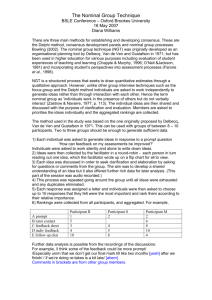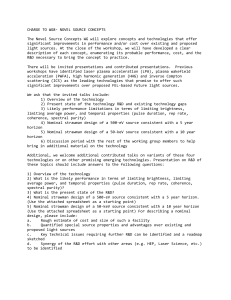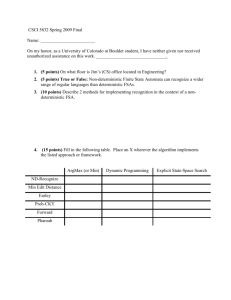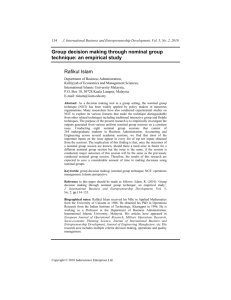Nominal Group Technique
advertisement
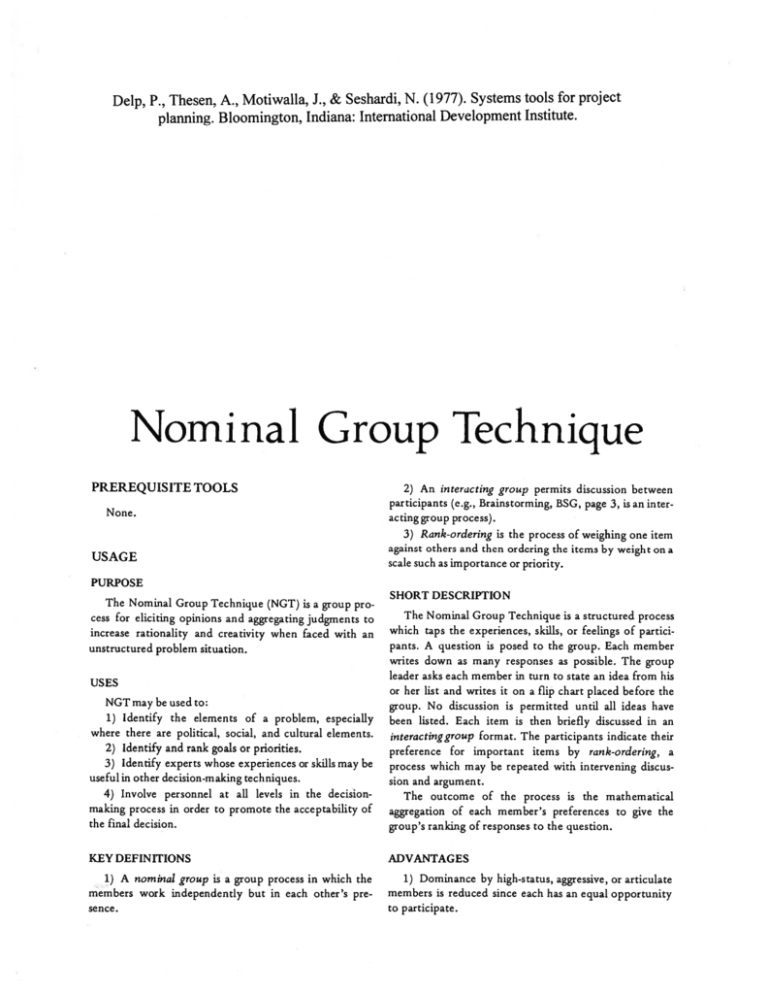
Deip, P., Thesen, A., Motiwalla, J., & Seshardi, N. (1977). Systems tools for project planning. Bloomington, Indiana: International Development Institute. Nominal Group Technique PREREQUISITE TOOLS None. USAGE 2) An interacting group permits discussion between participants (e.g., Brainstorming, BSG, page 3, is an inter acting group process). 3) Rank-ordering is the process of weighing one item against others and then ordering the items by weight on a scale such as importance or priority. PURPOSE The Nominal Group Technique (NGT) is a group pro cess for eliciting opinions and aggregating judgments to increase rationality and creativity when faced with an unstructured problem situation. SHORT DESCRIPTION NGT may be used to: 1) Identify the elements of a problem, especially where there are political, social, and cultural elements. 2) Identify and rank goals or priorities. 3) Identify experts whose experiences or skills may be useful in other decision-making techniques. 4) Involve personnel at all levels in the decisionmaking process in order to promote the acceptability of the final decision. The Nominal Group Technique is a structured process which taps the experiences, skills, or feelings of partici pants. A question is posed to the group. Each member writes down as many responses as possible. The group leader asks each member in turn to state an idea from his or her list and writes it on a flip chart placed before the group. No discussion is permitted until all ideas have been listed. Each item is then briefly discussed in an interacting group format. The participants indicate their preference for important items by rank-ordering, a process which may be repeated with intervening discus sion and argument. The outcome of the process is the mathematical aggregation of each member’s preferences to give the group’s ranking of responses to the question. KEY DEFINITIONS ADVANTAGES 1) A nominal group is a group process in which the members work independently but in each other’s pre sence. 1) Dominance by high-status, aggressive, or articulate members is reduced since each has an equal opportunity to participate. USES NOMINAL GROUP TECHNIQUE / 15 2) The group remains problem-conscious: and prema ture evaluation, criticism, or focusing on ideas is avoided. 3) The silent generation of ideas minimizes the interruptions in each person’s thought processes. 4) A written record increases the group’s ability to deal with a large number of ideas. It also avoids the loss of ideas. 5) Discussion only to clarify items helps eliminate misunderstanding, without reducing the group’s effici ency. 6) Some studies have shown that, compared to interacting group processes, e.g., Brainstorming (BSG, page 3), the Nominal Group Technique (NGT) enhances the conditions for creativity when generating information on a problem. It avoids rambling discourse and other de ficiencies found in group processes. LIMITATIONS 1) Cross-fertilization of ideas is diminished due to the structure imposed by the NGT. 2) The NGT may reduce flexibility, e.g., some group members may feel that the purpose of the meeting or the question posed is irrelevant or misleading, but they have no opportunity to change it. 3) Bringing group members together may be costprohibitive. REQUIRED RESOURCES LEVEL OF EFFORT Some administrative effort is required to determine the purpose of the meeting and to structure the proposed question. Potential group members need to be identified, notified, and assembled. SKILL LEVEL The leader of the nominal group should not bias the group toward his view; yet he must control unwanted group behavior without alienating people. SPECIAL REQUIREMENTS A flip chart and marking pens are needed for each group. Index cards (or similar small cards), approximately six per participant, facilitate the voting process. The seating arrangement must allow all members to easily focus on the ideas listed on the flip chart. Some means of displaying the completed chart pages is necessary (e.g., tacks or masking tape to afix them to the walls). DESCRIPTION OF TOOL SUPPLEMENTAL DEFINITION Round-robin is a process for serially recording ideas where each participant provides an idea in turn. No discussion occurs, although the leader may ask for a show of hands on how many participants had a similar idea. (This is noted next to the item on the list.) Those responding then eliminate that idea from their respective lists. The process may continue in a circular fashion until all participants’ lists are exhausted. REQUIRED INPUTS The nominal group generally includes fjvc to nine members. Less than five members may not allow for the quality and diversity of opinions required. Large groups produce more interpersonal differences, which lengthens the process without a substantial increase in the quality of output. If more than ten persons must participate, it is better to divide the group for the round-robin and combine them for final discussion and voting. The group leader may be directly involved in gener ating and discussing ideas. The composition of the group may be homogeneous or heterogeneous. Studies have shown that heterogeneous groups exhibit more creativity (Delbecq, 1975). But interpersonal differences and communication problems may increase for such groups. The NGT question provides the basis for generating the ideas. It should be worded to prevent misunder standing and should be stated as objectively as possible. TOOL OUTPUT The NGT produces a list of ideas and a rank-ordering of their importance. The group leader may wish to combine overlapping ideas under a common heading. TIME REQUIRED In a study quoted by Delbecq, et al. (1975), the total administrative man-hours to prepare, conduct, and fol low through for one group required an average of 4.4 hours for NGT, 4.2 hours for interacting processes, and 7.1 hours for the Delphi process (DLP, page 168). METHOD OF USE GENERAL PROCEDURE The general procedure for the Nominal Group Tech nique is straightforward. But because it runs counter to 16 / GENERATING IDEAS the experience of most people in leading groups or participating in committee work, the steps must be followed closely. With this in mind, the guidelines prescribed by the originators of the Nominal Group Technique have been reproduced below (Delbecq, Ct al., 1975, figure 3-7, page 6769):* 1. Silent generation of ideas in writing. 1.1 Present the nominal question to the group in writing. 1.2 Verbally read the question. 1.3 Illustrate level of abstraction and scope desired with example which does not distort (lead) group responses. 1.4 Avoid other requests for clarification. 1.5 Charge the group to write ideas in brief phrases or statements. group members to work silently and Ask 1.6 independently. 1.7 Model good group behavior. 1.8 Sanction disruption of the silent, independent activity by comments addressed to group as a whole. Benefits: 1) Provides adequate time for thinking. 2) Facilitates hard work by the model of other group members reflecting and writing. 3) Avoids interruption of each other’s thinking. 4) Avoids premature focusing on single ideas. 5) Eliminates dominance by high-status or aggressive members in idea generation. 6) Keeps the group problem-centered. 2. Round-robin recording of ideas on a flip pad. 2.1 Indicate objective of the step is to map the group’s thinking. 2.2 Explain need to present ideas in brief words or phrases. 2.3 Explain process of taking one idea serially from each member. 2.4 Explain group members must decide if items are duplicates. 2.5 Explain that an individual may “pass” when he has no further items, but may “re-enter” later. 2.6 Express the desirability of hitchhiking and adding new ideas even if they are not on individual nominal worksheets. 2.7 Explain inappropriateness of discussion prior to completion of listing. * From Group Techniques for Program Planning by Andre L. Delbecq, Andrew Van de Ven and Dsvjd H. Gustafson. Copyright (c) 1975 by Scott, Foresman and Company. Reprinted by per- mission. Record ideas as rapidly as possible. Record ideas in the words used by group members. 2.10 Provide assistance in abbreviating only in spe cial situations. 2.11 Make the entire list visible by tearing off completed sheets and taping them on an area visible to all group members. 2.12 Sanction group as a whole if individuals engage in side conversations or attempt to discuss items prior to completing the listing. 2.8 2.9 Benefits: 1) Equalizes opportunity to present ideas. 2) Assists in separating ideas from personalities. 3) Provides a written record and guide: a) Increases group’s ability to deal with a larger number of ideas. b) Avoids loss of ideas. c) Confronts the group with an array of clues. d) Encourages hitchhiking. 4) Places conflicting ideas comfortably in front of group. 5) Forces the group to fully explore the problem. 3. Serial discussion for clarification. 3.1 Verbally define the purpose of the step: a) To clarify the meaning of items. b) To explain reasons for agreement or dis agreement. 3.2 Indicate that final judgments will be expressed by voting, so arguments are unnecessary. 3.3 Pace the group so that all ideas receive suffici ent time for clarification. forcing the member who originally lists Avoid 3.4 the idea to be solely responsible for clarifying the item. Benefits: 1) Avoids having discussion focus unduly on any particular idea or subset of ideas. 2) Helps eliminate misunderstanding. 3) Provides opportunity to express the logic behind items. 4) Allows members to disagree without argumenta tion. 4. Preliminary vote on item importance. 4.1 Ask the group to select from the entire list a specific number (7 ± 2) of priority (important) items. * aFiveto nine items are all that can be effectively ranked on one dimension of discrimination (see Rating Scales, RTS, page 29). NOMINAL GROUP TECHNIQUE / 17 FIGURE 1 Index Card Illustrating Rank-Order Voting Process Number EXAMPLE 15 from original group Brief dc scrip tb n of item #15 list 6 Number indicating ran k-order 4.2 Place each priority item on a separate 3 x 5 card or ratingform see figure 11. 4.3 4.4 Rank-order or rate the selected priority items. Collect the cards or rating forms and shuffle them to retain anonymity. Tally the vote and record the results on the flip chart in front of the group. 4.5 Benefits: 1) Obtaining independent judgments in writing helps eliminate social pressures. 2) Expressing judgments mathematically by rankordering or rating increases accuracy of judgments. 3) Displaying the array of individual votes clearly high lights areas needing further clarification or discussion. 5. Discussion of the preliminary vote. 5.1 Define the role of the step as clarification, not pressure toward artificial consensus. 5.2 Keep the discussion brief. 5.3 Caution group members to think carefully about any changes they make in their voting. Benefits: 1) Provides group members a final opportunity to clarify their positions. 2) Ensures that “spread” votes really reflected dif ferences in judgment, not unequal information or misunderstanding. 6. Finalvote. 6.1 Repeatstep4. 6.2 Closure to the meeting. The steps of the Nominal Group Technique have been presented in a straightforward procedure which reflects a structured group process. The following example high lights some of the key points in this process and illustrates typical intermediate products generated by the tech n ique. The Ministry of Health for the government of Temasek wanted to analyze the state of the health delivery service. The evaluation staff elected to use the Nominal Group Technique and brought together a diverse group of physi cians, rural health technicians, public health personnel, field personnel, and a cross-section of clients (from dif ferent income and social classes). Silent Generation of Ideas in Writing The assembled participants were broken into groups of nine by randomly selecting participants representing rele vant occupations. After the opening welcome and a brief explanation of the Nominal Group Technique and the objectives for the afternoon, each participant was given a single sheet headed with the following question: WHAT ARE THE BARRIERS TO RECEIVING ADEQUATE HEALTH CARE IN OUR COUNTRY? The participants were allowed 15 minutes to list re sponses from their own viewpoints. Recording of ideas on a Flip Pad The leader for each group (a member of the evaluation staff trained in NGT) acted as the recorder to serially list the ideas. Some of the ideas generated by one group ineluded: 1) 2) 3) 4) 5) 6) No money to pay for services Lack of adequate facilities Too many doctors in the cities Not enough trained personnel Over reliance on traditional remedies Not enough doctors Note that this list contains some contradictions. The leader deferred discussion until the next step. However, when item 6 was voiced, someone asked whether this was the same as item 4 since doctors are included in trained personnel. The leader asked the participant if he thought item 6 should be dropped. The reply was negative, and the round-robin recording continued. All of the groups generated 15 or more items. Benefits: Accurate aggregation of group judgments and error re duction. aThis example is adapted from an exercis e conducted by one of the authors at a workshop to enable county health agenci es to plan for the treatment of alcoholics. 18 / GENERATING IDEAS Serial Discussion for Clarification During the discussion of each item, the participants clarified their responses, e.g., since trained personnel can f the physician, items 4 and 6 replace many functions 0 deserved separate consideration. Item 5 included going to a traditional village healer instead of tile nearest clinic. Preliminary Vote on Item Importance Each participant was asked to rank (from the list) the five most significant barriers to receiving adequate health care. The tally of the vote was recorded on the flip chart, using the numbers from the items. A vote of five meant that the participant viewed that item as the most signifi cant barrier. The votes for the first six items were: Item Number Votes Total 1) 2) 3) 4) 5) 6) 4,1 5,4 2,2,4 3,5,3 1 3,5 5 9 8 11 1 8 Discussion and Final Vote During the discussion following the first vote, the parti cipant who had presented item 5 expressed his amazement that the other members had not found the interference of superstitions and traditional healers to be a barrier. Other participants were not swayed by his arguments, and the final vote on the item was unchanged. Totaling the indi vidual rankings for each of the above items gave item 4 the most weight (11) followed by item 2 (9) and item 6 (8). Note that this example is incomplete since the rest of the list has not been presented, but the essential idea remains the same. A group with rather large status differences was able to use the Nominal Group Technique to identify and rank problems in receiving health care. THEORY The Nominal Group Technique is the result of analysis and experimentation with group processes for effective planning and decision making, and is credited to Van de Ven and Delbccq (Delbecq, eta1., 1975). The creativity of a group is an important determinant of its success. Types of group processes and leadership techniques for allowing creativity have been discussed widely (Maier, 1970; Osborn, 1957;Collins and Guetzkow, 1964). The Nominal Group Technique utilizes the mathemati cal aggregation of group judgments to come to a group de cision. The theory is discussed by 1-luber and Delbecq (1972). The advantages over conventional means for com ing to a group decision (e.g., consensus or majority rule) are described by Delbecq, et al. (1975). BIBLIOGRAPHY Collins, B. E., and Guetzkow, H. A Social Psychology of Group Processes for Deci.don-Making. New York: John Wiley & Sons, 1964. Delbecq, André; Van de Ven, Andrew; and Gustafson, David. Group Techniques for Program Planning: A Guide to Nominal Group and Delphi. Chicago: Scott Foresman, 1975. Huber, George, and Delbecq, André. “Guidelines for Com bining the Judgment of Individual Members in Deci sion Conferences.” A caderny ofManagem en tJournal l5(June 1972): 161-74. Maier, Norman R. F. Problem Solving and Creativity in In dividuals and Groups. Belmont, Calif.: Brooks/Cole, 1970. Osborn, A. F. Applied Imagination. New York: Charles Scribner’s Sons, 1957.

